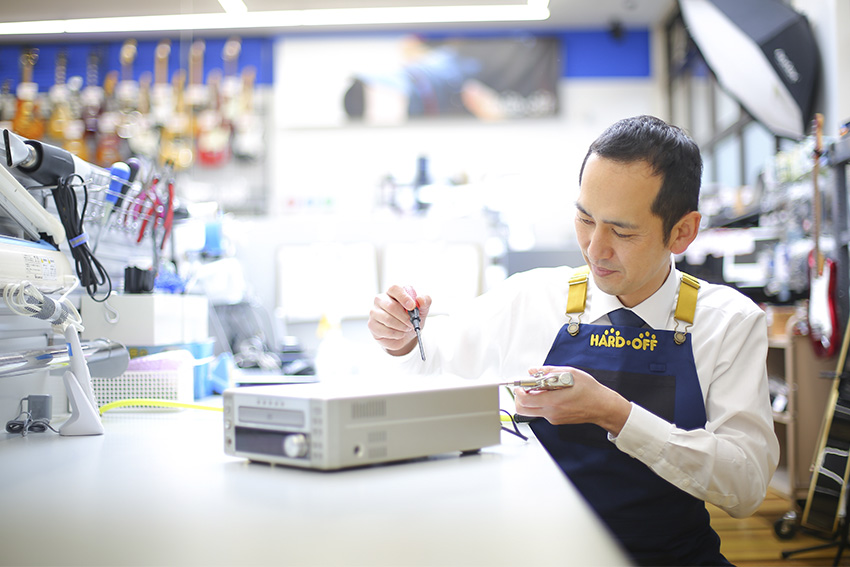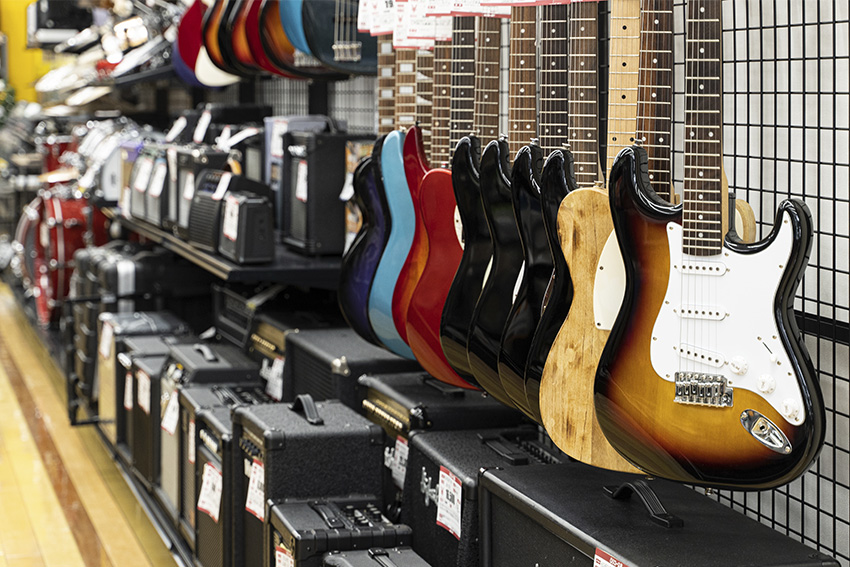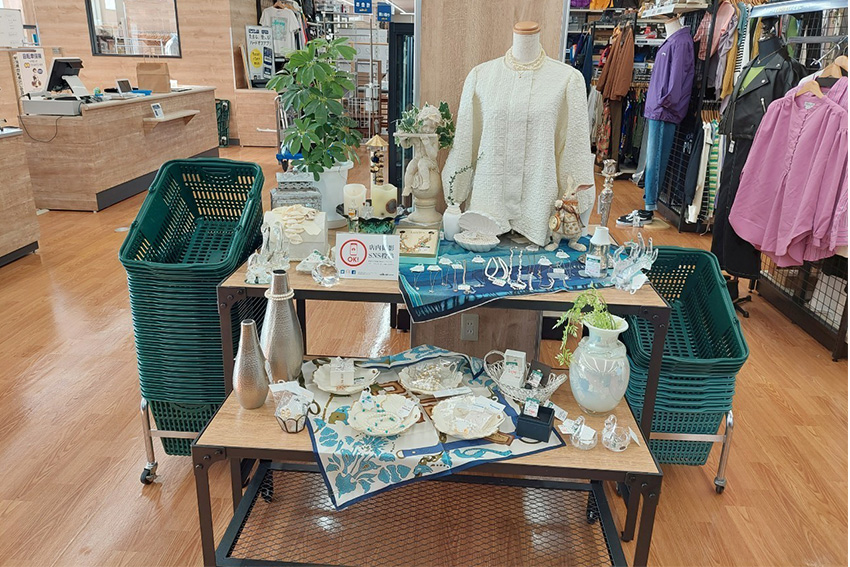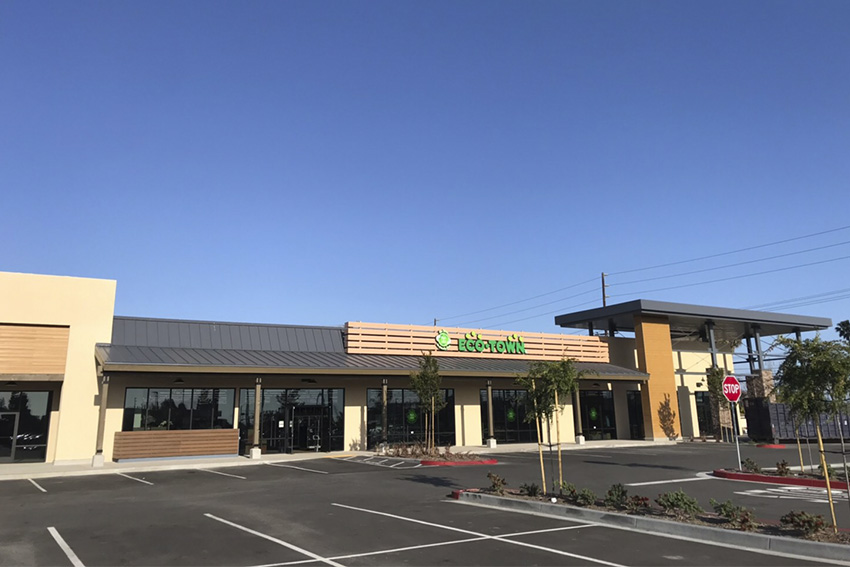Japan’s retail ecosystem is known for its niche retailers and lifestyle brands that thrive by meeting highly specific customer needs. This approach is gaining recognition not only within Japan, but internationally as well, with many visitors drawn to explore the unique strategies Japanese companies use in retail. How is a brand like yours evolving to meet changing consumer demands, and what do you see as the key strengths of Japanese retailers compared to their global counterparts?
One of our key strengths in this niche market lies in the variety of specialty brands we operate, including HARD OFF, HOBBY OFF, and BOOK OFF. Each store is managed by a dedicated store manager along with part-time staff. What sets us apart is our depth of knowledge within each specialty area—we’re able to go deep, not broad, and that expertise is central to our model.
Our business relies on purchasing items directly from consumers and reselling them. Without those purchases from the public, our model doesn’t function. If you ask most people who they would prefer to sell their items to, the common answer would be someone who understands and appreciates what they’re buying. That’s where our staff come in. They’re truly passionate about their product categories, whether it’s books, musical instruments, or collectibles. This passion and expertise help us attract customers who want to sell their items to someone who truly values them.
Another important aspect of our business is our franchise model. We currently have 37 franchise partner companies, and more than half of all our stores in Japan are operated by franchisees. Many of these franchise owners have a deep understanding of their local regions, which we see as a major strength in adapting our model to communities across the country.
You mentioned the importance of your staff and the deep knowledge and passion they bring to each specialty area. However, one of the major challenges facing Japanese businesses today is the country’s demographic crisis. Japan has the oldest population in the world, and with persistently low birth rates, the population is steadily declining. This has created a dual challenge: a labor shortage and a shrinking domestic market. These pressures are leading many Japanese companies to look overseas for growth opportunities. How is your company responding to these demographic challenges, and to what extent does internationalization factor into your strategy to address them?
Yes, you’re absolutely right in your analysis of Japan’s demographic challenges, particularly the declining birth rate and aging population. We operate stores across the country, including major locations in Akihabara and Niigata, as well as on Sado Island.
Our store on Sado Island opened about 20 years ago, when the population was around 90,000. Today, it has dropped to about 60,000. Even so, we can confidently say that the business is performing better now than it was back then. We’ve been facing this demographic challenge head-on, and while the situation is undeniably difficult, I try to remain optimistic. There are still many opportunities for growth, even in a shrinking population.

HARD OFF staff specializing in repairs
While Japan faces demographic challenges domestically, one segment that’s growing rapidly is inbound tourism. In 2024, Japan welcomed 36.8 million visitors, with numbers on track to reach 40 million this year and an ambitious goal of 60 million by 2030. Tourists often take the opportunity to visit stores like yours to purchase unique, secondhand items they can’t find elsewhere. You’ve mentioned flagship locations in Niigata and Akihabara—both of which have become must-visit spots for many international visitors. With this growing wave of inbound tourism, how is your company adjusting its strategy to maximize the spending of these tourists at your stores?
The first and most important step we’ve taken is offering tax-free incentives to tourists. In addition, we’ve installed multilingual signage throughout our stores so that visitors from different countries can easily navigate and find what they’re looking for. We also use multilingual announcements to help improve communication with international customers.
We’re now preparing to launch a new promotional campaign. Up to this point, most of our marketing efforts have focused on Japanese consumers, but we’re shifting toward international outreach. We’re planning to use platforms like YouTube to communicate in multiple languages and broaden our reach globally.
While we already have stores in key areas like Akihabara and Ueno, we currently don’t have locations in Shinjuku or Shibuya, which we recognize as important hubs for tourism.
Let me share an anecdote that left a strong impression on me. About two years ago, I returned to Japan from a trip to Germany. On the flight home, I was seated next to a husband and wife. During the meal, we struck up a conversation, and I asked how many times they had visited Japan. Their immediate response was, “HARD OFF,” which completely surprised me. That moment really stuck with me. It reminded me just how meaningful our stores can be to international visitors and underscored the importance of our inbound strategy. It also made me realize that even though we don’t have stores in Germany, people there are still familiar with Japanese retail brands like ours.
Earlier, you spoke about your unique approach—not just purchasing items, but also clearing, inspecting, and preparing them for retail. This level of care is quite distinct from what you might find outside Japan. For example, if you visit a pawnshop in the U.S., items typically aren’t displayed with the same attention to detail. Could you tell us more about how this process works and how HARD OFF’s approach sets it apart from other secondhand retailers?
It’s been nearly 33 years since we launched HARD OFF in 1993. At that time, there were already many secondhand stores in Japan, commonly referred to as “recycle shops.” However, they weren’t well regarded by consumers—these shops were often dimly lit, cluttered, and not particularly clean. They were commonly labeled as “5K” stores, with the “5K” referring to kaden (home appliances), kagu (furniture), kutsu (shoes), kappōgi (aprons and kitchenware), and kodomo-fuku (children’s clothing).
That reputation is exactly why we’ve taken a different approach. We make sure our stores are bright, clean, and welcoming—with staff who always greet customers with a smile. We call this the “Reverse 5K” model, and we truly believe this positive, customer-friendly environment is a key factor in our success.
One thing that stood out during our research is the growing importance of your ReNK Channel, which has become a key part of your mid-term roadmap by integrating digital tools with store-level operations. Looking at your impressive financial performance from 2021 to 2025—with net sales up 57% and earnings per share increasing by 500%—what role has ReNK played in that success? And what strategies are you implementing to maintain this strong trajectory of sales growth going forward?
About ten years ago, everyone in the retail industry was talking about omnichannel strategies. But I found the term vague and difficult to grasp, and frankly, many people didn’t fully understand what it actually meant or how to implement it effectively. Jumping into that space simply because others were doing so wouldn’t have led to success. As president, I knew I needed to clearly communicate any new strategy to our team—and “omnichannel” wasn’t something I felt I could explain in a way that truly resonated. That’s why we developed our own, more specific concept: the ReNK Channel.
The core idea behind ReNK is placing our physical stores at the center of the reuse cycle. About a decade ago, there was a growing perception that brick-and-mortar stores were becoming less relevant, with many shifting toward e-commerce. But I wanted to show that physical stores should not only remain relevant—they should be central to our business model.
There are two main reasons I believe physical stores continue to play a vital role. First, every product we sell is a unique stock keeping unit (SKU), which means each item is one of a kind. Customers naturally want to see and handle these items in person before making a purchase. Second, we have outstanding staff in our stores, and their expertise and customer service are a huge part of what makes the in-store experience valuable. I firmly believe that physical stores will continue to be a powerful draw for consumers.


Inside a Japanese HARD OFF store
Your company now has a presence in all 47 prefectures of Japan, and you’ve also expanded internationally with stores in Hawaii, California, Taiwan, Cambodia, and Thailand. Could you tell us more about your current international strategy and what led you to choose these specific locations?
When it comes to our overseas operations, we have two distinct business models—one for the U.S. and Taiwan, and another for Southeast Asia. In the U.S. and Taiwan, we follow the same model we use in Japan: focusing on secondhand product sales by purchasing items locally and selling them locally.
In contrast, our approach in Thailand and Cambodia is different. There, we operate what we refer to as a “third-hand” model. This involves shipping products from Japan that we’re unable to sell domestically and offering them for sale in these markets instead.
Your franchise model has been a major success, now accounting for 50% of your overall turnover. Is this franchise approach exclusive to your domestic operations, or are you planning to replicate it in overseas markets as well?
That’s a difficult question, but our primary goal is to replicate the success of our Japanese model in overseas markets. However, in order to expand horizontally through franchising, we first need to ensure the model is firmly established and profitable in each market.
In Taiwan, we successfully opened five stores, and based on that performance, we moved forward with a sixth store under the franchise model, which opened in May 2025. For us, the definition of success is achieving at least a 20% profit margin. In Japan, our average profit margin exceeds 20%, and Taiwan has reached a similar level. In contrast, the U.S. market currently sits at around a 10% margin. Until we can raise that figure above 20%, we won’t be considering franchising there.
What do you believe is currently missing or needs to change in order to reach that 20% profit margin target in the U.S. market?
At this point, I’m not entirely sure. That said, we’ve made real progress. Up until last year, our U.S. business wasn’t profitable at all, so the fact that we’re seeing improvements now is encouraging. When we first entered the market in 2017, we tried to “Americanize” the store concept—but that approach didn’t work. We’ve since shifted to offering a more Japanese-style experience, and this adjustment has started to bring results. In hindsight, we should have simply replicated the successful model we use in Japan.
When entering a new market, the first thing we consider is how strong the local interest is in Japanese culture and products. Taiwan, for example, has many pro-Japanese consumers who genuinely appreciate our country and what we offer. Our store in Hawaii has also performed very well, with strong positive feedback from customers. Building on that success, we looked to expand to the mainland U.S. and chose Orange County, which we felt offered a safe and stable environment.
Before entering the U.S., we conducted a great deal of research to evaluate opportunities in the reuse retail space, including garage sales, flea markets, and swap meets. We found that the U.S. is quite advanced in this area, but there were still no stores quite like ours. That’s when we saw the U.S. as a blue ocean—a wide-open market—and felt a kind of social responsibility to bring our model there.
One major challenge we’ve faced is that while we launched with a Japanese-style store concept, it’s taken time for American consumers to become aware of who we are and what we offer. Because there’s nothing quite like us in the market, it’s been difficult to position and promote ourselves effectively.

HARD OFF in the US
If you had to describe the HARD OFF experience to someone unfamiliar with the brand, how would you explain it in just a few sentences?
There are two main types of customers at HARD OFF—those who want to sell to us, and those who come to buy. For buyers, we often describe the HARD OFF experience as a treasure hunt. You never know what you’ll find, and that excitement is part of the appeal. For sellers, we focus on building trust. We want people to feel confident and secure when they bring their items to us.
One particularly interesting part of our stores is what we call the “Junk Corner,” where we sell broken or untested products without any warranty. Surprisingly, it’s one of the most popular sections. When we open a new store, it’s not uncommon to see 300 people lined up—and the majority of them head straight to the Junk Corner.
When it comes to expanding into international markets, what role do partnerships play in your strategy? Are you currently seeking any new international partnerships or collaborations?
In Taiwan, we hold a 70% stake in the local operation, while the remaining 30% is owned by two local companies. This structure allows us to benefit from their insights and guidance in navigating the market. In the U.S., however, our business is 100% owned by us, meaning we’re operating independently. That said, we are actively looking for a partner in the U.S. market.
There are many forms a partnership can take, but for us, the franchise model is the most suitable. The U.S. already has a strong franchise culture, with many established players. At the same time, traditional retail in the U.S. is facing major challenges due to the rise of e-commerce platforms like Amazon. Many American retailers are likely going through difficult times, so we hope that some may discover us and consider a collaboration.
Globally, our strategy is to continue growing in Taiwan, where we believe there’s still plenty of untapped potential. As for the U.S., we’re committed to making it a success. Proving our model works in the Western market would give us the confidence and credibility to expand into other countries as well.
If we were to sit down for this interview again two years from now, what goals or aspirations would you hope to have accomplished by that time?
In two years, I hope we’ll be able to talk about our success in the U.S. market—specifically, reaching a profit margin of over 20% and expanding our franchise business beyond the U.S. into other countries and regions. For Southeast Asia, our goal is to transition fully into the secondhand business model.
I believe Japan’s reuse culture is something truly unique and deeply rooted in our society. While it may be specific to Japan today, our vision is to make this culture global—to share our message and way of doing things with the world.
For more information, please visit their website at: https://www.hardoff.info/

AloJapan.com